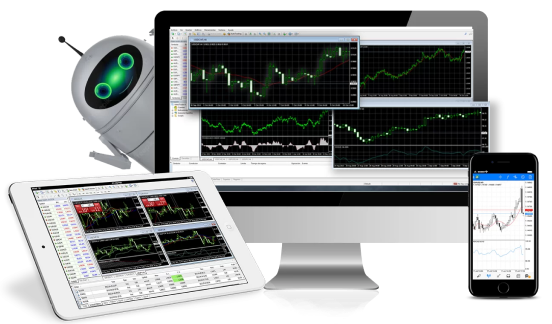When trading Forex, you are effectively buying or selling a particular currency for its counterpart . If you decide to buy a currency pair, you will be hoping that the base currency will appreciate against its counterpart. The opposite will be true if you sell a currency pair.
How to Place A Trade
All currency pairs are quoted at two prices – the buying (or ask) price and the selling (or bid) price.
The difference between two values is known as the “Spread” and signifies how much a broker will charge to open the position.
Quotes are usually displayed up to four decimal places, for example, 1.2345. If we say that the EUR/GBP price is 1.2345, a trader will need to invest 1.2345 GBP for each EUR they wish to buy.
Any change in a currency’s value will usually be seen in the fourth decimal place, or “pip.” The spreads, gains, and losses of each trade are therefore displayed as pips.
For example, if a trader opens a buying position for EUR/GBP at a quote of 1.2345, and closes their position at 1.2347, they have made a profit equivalent to two pips.
First of all, to place a trade, check the ask and bid prices, then decide whether you wish to buy or sell the pair. You will then choose the number of units you wish to trade.
Understanding leverage
Leverage is the use of borrowed funds to increase one’s trading position beyond what would be available from their cash balance alone. For example, if you are required to deposit 1% of the total transaction value as margin and you intend to trade one standard lot of USD/CHF, which is equivalent to US$100,000, the margin required would be US$1,000. Thus, your margin-based leverage will be 100:1 (100,000/1,000). For a margin requirement of just 0.25%, the margin-based leverage will be 400:1, using the same formula.
Leverage has the potential to enlarge your profits or losses by the same magnitude. The greater the amount of leverage on the capital you apply, the higher the risk you will assume. Note that this risk is not necessarily related to margin-based leverage, although it can influence if a trader is not careful that’s why you should always use leverage wisely.
Traders use leverage to make their capital go further, and also potentially increase the size of their profit. However, it is important to remember that it can also magnify any losses if the markets move a different way to how you predicted. As a result, you should always use leverage wisely and never invest more than what you can afford to lose.
To illustrate how effective leverage can be, let us assume that the $100,000 trading position mentioned above made a $1,000. If the trader were only using the leverage of 1:1, the profit they would take would only be 1% (a $1,000 gain from a $100,000 investment). However, a leverage of 1:100 would yield a profit of 100% (a $1,000 gain from a $1,000 initial payment).
Of course, leverage can work both ways. If the $100,000 trading position makes a loss of $1,000, the trader would only make a loss of 1% if they used the leverage of 1:1. However, they would stand to lose 100% if they used the leverage of 1:100.
What is margin?
A margin is defined as the amount of money the trader must invest in opening a position. If we use the $100,000 example above, the margin would either be $100,000 using a 1:1 leverage or $1,000 with a ratio of 1:100.
To calculate the margin needed to place a trade, divide the deal amount by the leverage (for example, 100,000 / 100 = 1,000). Margins are always expressed as a percentage.
Used & free margins
A used margin is the amount of money that a trader has tied up in their open positions. For example, if they had opened a $100,000 position with a $1,000 investment, the $1,000 would be the used margin – assuming this is the only position they had open at the time.
A free margin is any remains funds in the trading account that are not tied up in open positions. If we assume that a trader deposited $10,000 in their trading account and opened a position in which they invested $1,000 as a margin, the free margin-left in the account would be $9,000.
Provided this position does not stray into negative territory, the trader would be able to invest the full $9,000 in new trades.
Margin calls
A margin call refers specifically to a broker’s demand that an investor deposit additional money or securities into the account brought up to the minimum value, known as the maintenance margin. A margin call is usually an indicator that one or more of the margin account’s securities have decreased in value. When a margin call occurs, the investor must either deposit more money in the account or sell some of the assets held in their account.
For example, suppose an investor opens a margin account with $5,000 of their own money and $5,000 borrowed from the company as a margin loan. They purchase 200 shares of a stock on margin at $50. Assume that this investor’s broker’s maintenance margin requirement is 30%.
The investor’s account has $10,000 worth of stock in it. In this example, a margin call will be triggered when the account value falls below $7,142.86 (i.e., margin loan of $5,000 / (1 – 0.30), which equates to a stock price of $35.71 per share.
Using the example above, let’s say the price of this investor’s stock falls from $50 to $35. Their account is now worth $7,000, which triggers a margin call of $100.
The investor has one of three choices to rectify their margin deficiency of $100:
1. Deposit $100 cash in the margin account, or
2. Deposit marginable securities worth $142.86 in their margin account, which will bring their account value back up to $7,142.86, or
3. Liquidate stock worth $333.33, using the proceeds to reduce the margin loan; at the current market price of $35, this works out to 9.52 shares, rounded off to 10 shares.
Bulls and bears
Throughout your trading journey, the two phrases you will likely hear a lot are bulls and bears. These terms are commonly used to describe market fluctuations or even investors themselves.
A bull market is where an asset is on an upward trajectory, while a bear market signifies a trajectory in the opposite direction. When it comes to traders, a bull is aggressive and likes to attack the market, while a bear tends to be more defensive and pessimistic.
The actual origin of these terms is unclear, although a popular theory is thought to derive from how each animal attacks its opponents. Bulls tend to thrust their horns up in the air, while bears will swipe downwards.
Currency pair classifications
There are three categories of currency pairs – majors, minors and, exotics. Major currency pairs
Major currency pairs consist of the most frequently traded currencies globally. Because they have massive liquidity, you’re able to trade them virtually always. Furthermore, you’ll find the lowest spreads — or brokerage costs — when trading these pairs.
Major currency pairs include:
| Currency pairs | |
|---|---|
| EUR/USD | Euro/US dollar |
| USD/JPY | US dollar/Japanese yen |
| GBP/USD | British pound/US dollar |
| USD/CHF | US dollar/Swiss franc |
| USD/CAD | US dollar/Canadian dollar |
| AUD/USD | Australian dollar/US dollar |
| NZD/USD | New Zealand dollar/US dollar |
When a currency pair doesn’t include the US dollar, it’s called a minor currency pair or a cross-currency pair.
Here are a few minor currency pairs:
| Minor currency pairs | |
|---|---|
| EUR/GBP | Euro/British pound |
| EUR/AUD | Euro/Australian dollar |
| GBP/JPY | British pound/Japanese yen |
| CHF/JPY | Swiss franc/Japanese yen |
| NZD/JPY | New Zealand dollar/Japanese yen |
| GBP/CAD | British pound/Canadian dollar |
| EUR/GBP | Euro/British pound |
An exotic currency pair includes a major currency and the currency of a developing economy (such as Brazil or South Africa). You won’t find exotic pairs as often as you’ll find major or minor pairs, which means the spreads can be higher when trading them.



